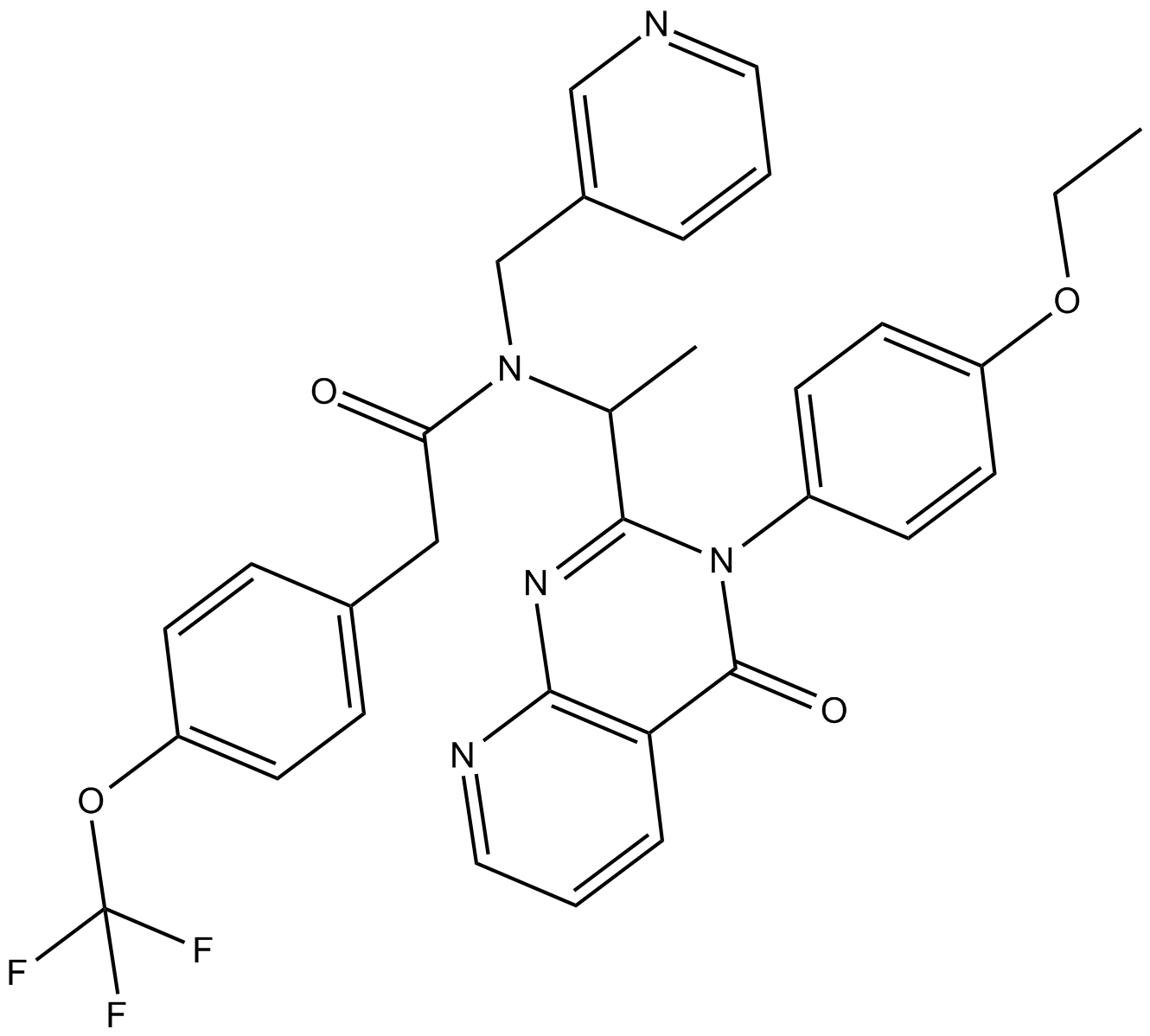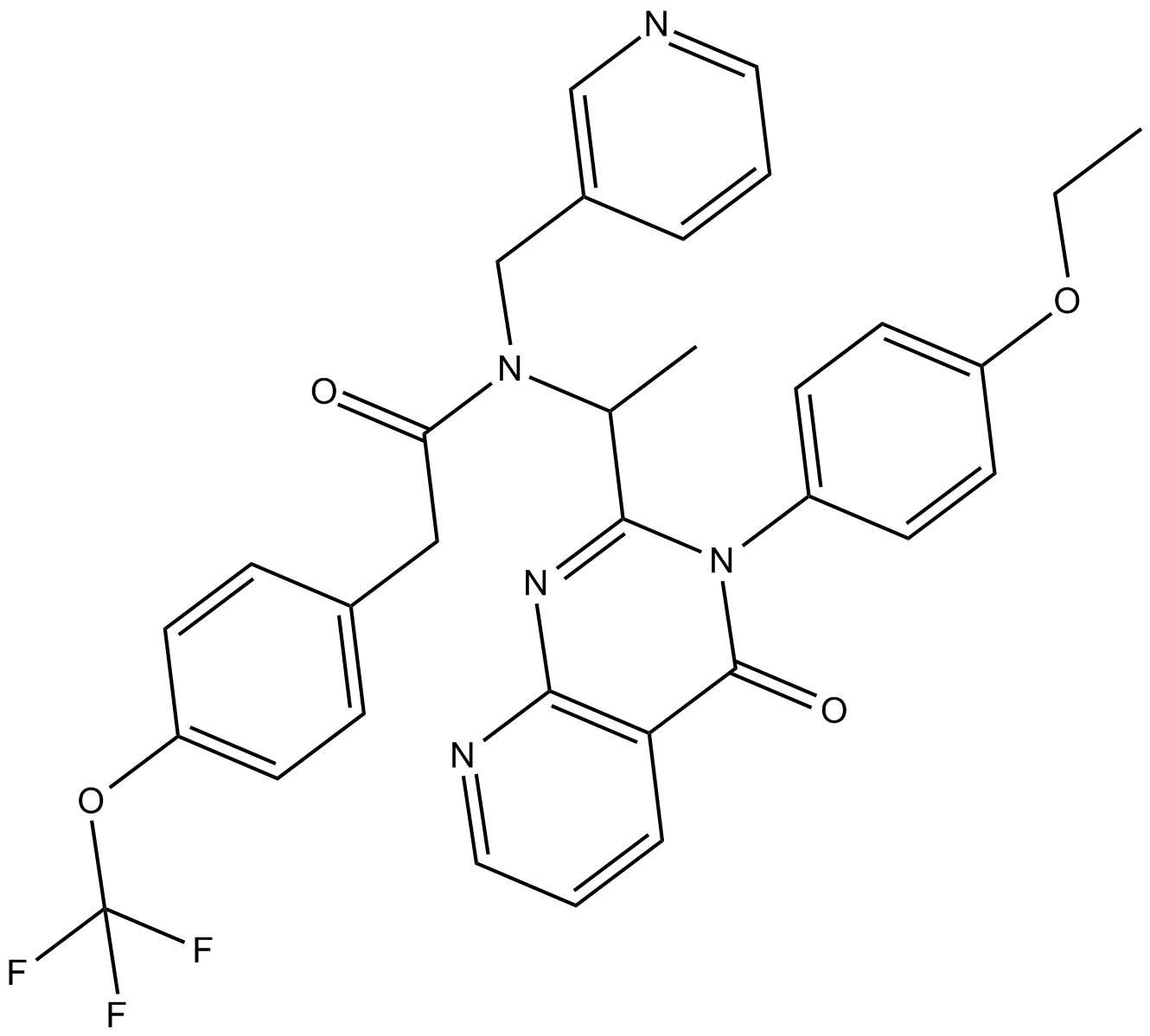(±)-AMG 487
AMG 487 is described here instead of (±)-AMG 487. AMG 487 is a potent and selective antagonist of chemokine (C-X-C motif) receptor 3 (CXCR3) [1]. AMG 487 inhibited CXCR3-mediated cell migration induced by three CXCR3 chemokines, IP-10, ITAC and MIG with IC50 values of 8, 15 and 36 nM, respectively [2].
CXCR3, a chemokine receptor, is primarily expressed on activated CD4+ and CD8+ T cells with a Th1 phenotype. It is also expressed on B cells, malignant T cells, natural killer (NK) cells and astrocytes. Its ligands are Mig (CXCL9), IP-10 (CXCL10), and ITAC (CXCL11). These ligands are primarily induced by IFN-γ. CXCR3 and its ligands had been implicated in many inflammatory diseases including inflammatory bowel diseases, rheumatoid arthritis, psoriasis, multiple sclerosis, and transplant rejection [2].
AMG487 blocked in vitro lymphocyte migration mediated by CXCL9, CXCL10 or CXCL11. AMG487 did not affect the proliferation of 66.1 tumor cells at 24, 48 or 72 hours under normal or serum-free growth conditions. It did inhibit the migration of the tumor cells to CXCL9 by 70% [3].
In the lungs of mice, treatment with bleomycin via intra-tracheal instillation after tracheostomy induced cellular recruitment into the lungs. All but the lowest dose AMG 487 treatment group showed significant decrease in cellular infiltration into the lungs (p < 0.005 as determined by Student’s t-test). Subcutaneously administration with AMG 487 at 3 mg/kg twice daily showed migration inhibition results similar to those of CXCR3 deficient mice (n = 8-12 mice per group) [2]. The highly malignant murine mammary tumor cell line 66.1 was pretreated with AMG 487 and hence i.v. injected into immune-competent female mice. AMG487 showed inhibitory effect on experimental lung metastasis [3].
References:
[1]. Tonn GR, Wong SG, Wong SC, et al. An inhibitory metabolite leads to dose- and time-dependent pharmacokinetics of (R)-N-{1-[3-(4-ethoxy-phenyl) -4-oxo-3,4-
dihydro-pyrido[2,3-d]pyrimidin-2-yl]-ethyl}-N-pyridin-3-yl-methyl-2-(4-trifluoromethoxy-phenyl)-acetamide (AMG 487) in human subjects after multiple dosing. Drug Metabolism and Disposition, 2009, 37(3): 502-513.
[2]. Johnson M, Li AR, Liu J, et al. Discovery and optimization of a series of quinazolinone-derived antagonists of CXCR3. Bioorganic & medicinal chemistry letters, 2007, 17(12): 3339-3343.
[3]. Walser TC, Rifat S, Ma X, et al. Antagonism of CXCR3 inhibits lung metastasis in a murine model of metastatic breast cancer. Cancer research, 2006, 66(15): 7701-7707.
| Storage | Store at -20°C |
| M.Wt | 603.59 |
| Formula | C32H28F3N5O4 |
| Solubility | <60.36mg/ml in DMSO |
| Chemical Name | N-(1-(3-(4-ethoxyphenyl)-4-oxo-3,4-dihydropyrido[2,3-d]pyrimidin-2-yl)ethyl)-N-(pyridin-3-ylmethyl)-2-(4-(trifluoromethoxy)phenyl)acetamide |
| SDF | Download SDF |
| Canonical SMILES | CCOC1=CC=C(N2C(C(N(C(CC3=CC=C(OC(F)(F)F)C=C3)=O)CC4=CN=CC=C4)C)=NC5=C(C2=O)C=CC=N5)C=C1 |
| Shipping Condition | Small Molecules with Blue Ice, Modified Nucleotides with Dry Ice. |
| General tips | We do not recommend long-term storage for the solution, please use it up soon. |
Quality Control & MSDS
- View current batch:
-
Purity = 98.00%
- COA (Certificate Of Analysis)
- MSDS (Material Safety Data Sheet)
Chemical structure









